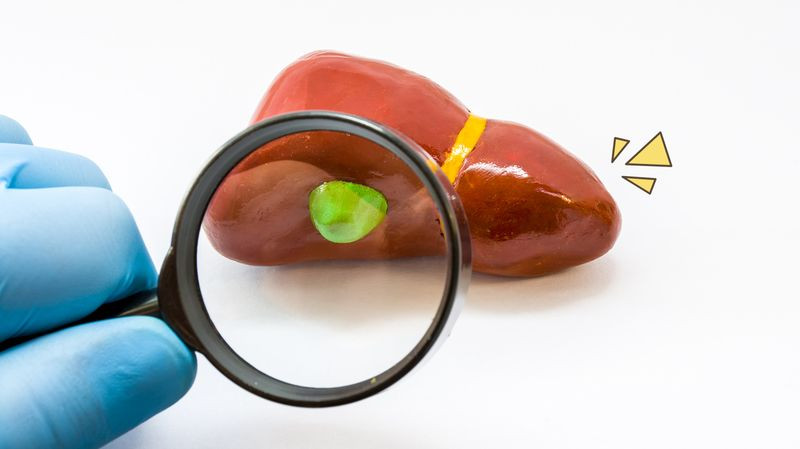Definisi
Karsinoma kandung empedu atau kanker kandung empedu adalah pertumbuhan sel yang tidak normal dan berlebihan di kandung empedu. Sel tubuh memiliki siklus hidup dan kematian yang jelas. Bila sel tubuh bermutasi, sel yang seharusnya mati akan tetap hidup dan terus bertumbuh tidak normal, kemudian berkembang menjadi kanker.
Kandung empedu berada di bawah organ hati, di sisi kanan perut. Ukuran kandung empedu kecil dan berbentuk seperti pir. Kandung empedu berfungsi untuk menampung cairan empedu yang dihasilkan oleh hati. Cairan empedu bekerja untuk mencerna lemak yang terkandung dalam makanan selama melewati usus.
Karsinoma kandung empedu adalah penyakit yang cukup langka. Jenis kanker ini adalah kanker saluran cerna keenam tersering di dunia, namun di Amerika Serikat, hanya sekitar 12 ribu orang yang didiagnosa dengan karsinoma kandung empedu pada tahun 2019.
Angka kesembuhannya cukup tinggi bila ditemukan pada stadium awal. Namun, umumnya karsinoma kandung empedu baru ditemukan di stadium akhir karena pasien jarang mengalami gejala bila penyakit masih berada di stadium awal. Lokasi kandung empedu yang tersembunyi di bawah hati juga membuat penyakit ini sulit terdeteksi. Meski begitu, seseorang masih dapat tetap hidup tanpa kandung empedu.
Penyebab
Masih belum jelas apa yang menyebabkan terjadinya mutasi genetik pada sel, sehingga terbentuk jaringan tumor ganas pada kandung empedu. DNA sel mengandung instruksi agar sel bisa bekerja secara normal. Bila terjadi mutasi gen, hal ini bisa membuat instruksi DNA pada sel berubah, sehingga sifat sel berubah menjadi:
- Sel tidak mati seperti sel normal lainnya
- Bertumbuh terus secara tidak terkendali
- Sifat sel menjadi ganas dan bisa menginvasi sel sehat di sekitarnya
Jumlah sel yang terus bertumbuh dan bertambah akan membentuk jaringan tumor. Tumor bisa tumbuh dan melebihi kandung empedu serta menjadi ganas. Sel kanker ini pada akhirnya akan memiliki kemampuan untuk menyebar ke bagian tubuh lain.
Karsinoma kandung empedu biasanya diawali pada perubahan sel kelenjar pembantu yang melapisi lapisan dalam kandung empedu. Kanker yang berkembang dari sel ini disebut sebagai adenokarsinoma kandung empedu. Hampir semua karsinoma kandung empedu adalah adenokarsinoma.
Faktor Risiko
Faktor yang dapat meningkatkan risiko terjadinya karsinoma kandung empedu adalah:
- Jenis kelamin, kasus lebih banyak ditemukan pada perempuan.
- Usia, risiko kanker kandung empedu meningkat seiring bertambahnya usia.
- Riwayat batu kandung empedu sebelumnya, khususnya yang batunya berukuran besar.
- Penyakit atau kelainan kandung empedu lainnya. Seperti adanya polip, peradangan kronis atau jangka waktu lama, dan infeksi.
- Peradangan di saluran empedu.
- Riwayat karsinoma kandung empedu pada anggota keluarga.
Gejala
Karsinoma kandung empedu biasanya jarang menimbulkan gejala bila kanker masih berada di stadium dini. Terkadang pasien baru merasakan keluhan saat kanker sudah menyebar ke kelenjar getah bening atau organ tubuh lainnya. Gejala yang dapat muncul dari penyakit ini adalah:
- Nyeri perut, biasanya dirasakan di sisi kanan atas perut.
- Perut kembung.
- Penurunan berat badan tanpa penyebab yang jelas.
- Kulit dan mata berwarna kuning (jaundice).
- Mual dan muntah.
- Terlihat benjolan di bagian perut.
- Demam yang tidak diketahui penyebabnya.
- Urine berwarna gelap.
Diagnosis
Diagnosis karsinoma kandung empedu ditegakkan oleh dokter dengan wawancara gejala dan pemeriksaan. Dokter akan langsung memeriksa bagian tubuh yang dirasakan mengalami keluhan serta pemeriksaan yang berkaitan lainnya. Dokter juga dapat melakukan pemeriksaan tambahan seperti:
- Pemeriksaan darah, dilakukan untuk membantu dokter menilai fungsi organ hati dan ginjal, mencari tanda infeksi bila ada, dan memeriksa komponen darah.
- Prosedur radiologi, bertujuan untuk memberikan gambaran kandung empedu dari luar serta mencari tahu bila sel kanker sudah menyebar ke organ lain. Contoh pemeriksaan yang bisa dilakukan adalah:
- USG
- CT Scan
- MRI
Ketika diagnosis karsinoma kandung empedu sudah tegak, dokter akan melakukan pemeriksaan tambahan untuk menentukan stadium kanker dan jenis kanker yang dialami. Informasi tersebut berguna untuk memilih terapi yang bisa dilakukan dan untuk mengetahui perkiraan kesembuhan serta harapan hidup pasien. Stadium karsinoma kandung empedu dimulai dari stadium 0 hingga stadium 4 (stadium akhir). Beberapa prosedur dan tes penunjang lain yang bisa dilakukan di antaranya:
- Operasi eksplorasi
Dokter akan melakukan prosedur operasi di bagian untuk melihat penyebaran dari kanker empedu. Operasi dilakukan menggunakan laparoskopi yaitu kamera kecil yang berguna untuk melihat organ bagian dalam.
- ERCP (Endoscopic Retrograde Chilangiopancreatography)
Pemeriksaan ini berguna untuk melihat bagian dalam kandung empedu. Dilakukan dengan memasukkan zat warna ke dalam kandung empedu lalu dilakukan pemeriksaan pencitraan untuk melihat jalannya cairan. Dari pemeriksaan ini bisa diketahui bila ada sumbatan di saluran empedu.
- Biopsi
Pemeriksaan biopsi dilakukan dengan mengambil sampel sel jaringan tumor kandung empedu. Sampel tersebut kemudian akan diperiksa di bawah mikroskop untuk memastikan apakah sel tersebut merupakan sel kanker.
Tata Laksana
Tata laksana karsinoma kandung empedu disesuaikan dengan:
- Stadium kanker
- Kondisi kesehatan pasien secara menyeluruh
- Pilihan terapi yang mau dijalani oleh pasien
Tujuan penanganan adalah menghilangkan sel kanker kandung empedu dari tubuh. Tetapi bila sudah tidak dapat dilakukan, tujuannya adalah mengontrol penyebaran penyakit dan mengurangi gejala yang dirasakan. Dokter akan memberikan obat untuk mengurangi gejala seperti obat anti nyeri, obat mual, dan pemasangan oksigen bila dibutuhkan.
Operasi
Pada stadium awal karsinoma kandung empedu, prosedur operasi bisa menjadi pilihan pengobatan. Berdasarkan keputusan dokter, bisa dilakukan prosedur pengangkatan kandung empedu saja, atau turut mengangkat sebagian jaringan organ hati. Prosedur kedua dilakukan bila sel kanker sudah mulai menyebar ke sebagian area hati dan saluran empedu.
Operasi biasanya akan dilakukan bila kanker atau kandung empedu berukuran kecil. Meski sudah dilakukan operasi, dokter tetap akan menganjurkan metode terapi tambahan untuk menghancurkan sel-sel kanker yang masih tersisa.
Pilihan Pengobatan Lain
- Terapi radiasi
Terapi radiasi diberikan dengan menggunakan x-ray dan proton yang bersifat membunuh sel kanker. Umumnya diberikan bersama kemoterapi untuk memastikan seluruh sel kanker mati di tubuh setelah prosedur operasi.
- Terapi obat sesuai target
Terapi obat ini bertujuan untuk menyerang kelemahan spesifik yang ada dalam sel kanker agar sel kanker mati. Terapi ini menjadi pilihan pada stadium kanker kandung empedu yang lebih tinggi.
- Kemoterapi
Kemoterapi menggunakan obat khusus untuk membunuh sel kanker dengan cepat. Obat kemoterapi bisa diberikan melalui pembuluh darah atau diminum. Selain diberikan setelah prosedur operasi, kemoterapi juga bisa menjadi pilihan terapi untuk mengatasi gejala dan memperpanjang harapan hidup pasien.
- Imunoterapi
Imunoterapi dilakukan dengan pemberian obat yang dapat membantu dan meningkatkan sistem kekebalan tubuh untuk melawan sel kanker. Imunoterapi berfungsi untuk membantu sistem imun untuk mengenal sel yang berbahaya. Terapi ini menjadi salah satu pilihan pengobatan pada stadium lebih lanjut dari karsinoma kandung empedu.
Komplikasi
Ada kemungkinan karsinoma kandung empedu bisa kambuh di kemudian hari. Pada pasien dengan kanker stadium dini, umumnya dokter akan mengobservasi pasien secara berkala setelah pengobatan selesai. Sehingga bila ditemukan gejala yang mencurigakan atau tanda kanker kembali kambuh, dokter bisa memulai pengobatan sejak dini.
Pencegahan
Tidak ada cara khusus untuk menegah karsinoma kandung emoedu. Beberapa faktor risiko seperti usia atau jenis kelamin sejak awal tidak dapat kita kontrol. Meski begitu ada beberapa cara untuk menurunkan risiko terjadinya karsinoma kandung empedu, di antaranya:
- Mempertahankan pola hidup sehat dengan konsumsi makanan yang sehat dan bergizi, rutin berolahraga, dan menjaga berat badan dalam batas normal.
- Tidak mengonsumsi alkohol.
- Tidak merokok atau berhenti merokok.
Kapan Harus ke Dokter?
Segera berobat ke dokter bila Anda mengalami gejala di atas. Lakukan pemeriksaan kesehatan rutin bila Anda memiliki faktor risiko. Penanganan lebih awal akan memberikan outcome yang lebih baik bagi kesehatan.
Mau tahu informasi seputar penyakit lainnya? Cek di sini, ya!
- dr Hanifa Rahma
Gallbladder cancer - Symptoms and causes. (2022). Retrieved 20 July 2022, from https://www.mayoclinic.org/diseases-conditions/gallbladder-cancer/symptoms-causes/syc-20353370
What Is Gallbladder Cancer?. Cancer.org. (2022). Retrieved 20 July 2022, from https://www.cancer.org/cancer/gallbladder-cancer/about/what-is-gallbladder-cancer.html.
Fox, E. (2021). Gallbladder Cancer: Practice Essentials, Background, Pathophysiology. Emedicine.medscape.com. Retrieved 20 July 2022, from https://emedicine.medscape.com/article/278641-overview.
Ranchod, Y. (2019). Gallbladder Cancer: Causes, Prognosis, Signs, and More. Healthline. Retrieved 20 July 2022, from https://www.healthline.com/health/gallbladder-cancer.











